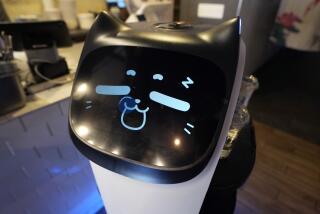Thirsty for beer? Thereâs a robot for that
Move over C3PO, Cornell University computer science geeks have created a robot that can tell if you want a beer and pour it for you. Barristas also may want to wake up and smell the coffee too. This robot can guess whether students are hankering for java and pour it for them.
Kodiak the robot was as handy with a lager as with a latte, could open refrigerator and microwave doors and even tidy up, say the human robotics researchers. In tests, the hard-wired humanoid correctly anticipated a studentâs next move between 57% and 82% of the time, depending on how far into the future it was âanticipating.â
Programmers broke down human movements, uses of objects, possible trajectories of motion and the intentions of activities, such as eating dinner or having a beer, said computer scientist Ashutosh Saxena, who works on personal robotics at Cornell. Along with graduate student Hema Koppula, Saxena built an algorithm around 120 videos of 10 common activities, giving the robot the flexibility to ârateâ the next move in a sequence and move accordingly.
âYou can think about human activities as a document in which there is a basic alphabet of what people can do, and we sequence things together to do long-term activities,â Saxena said. âWe all do very basic things, like move our arms, get up, hold something, eat something or drink something. Now we can put this together in a sequence to do a variety of things.â
Equipped with a Microsoft Kinect 3-D Camera, the robot would visualize the studentâs motions and the location of key objects, such as a coffee cup, Saxena said. When its guess of what came next proved wrong, Kodiak would re-assess new possibilities, in a way similar to a GPS mapping program changing driver instructions after a wrong turn.
The tasks were long, and some were complex, such as eating an entire dinner. Kodiak had to learn to pour beverages without interfering with other activities, or assist someone trying to microwave an entrée, Saxena said.
âIf it looks like they are picking something up, they may be putting something in the fridge,â Saxena said. âAnd if they are doing it, then this must be the trajectoryâ¦the robot can plan around it or plan for it. It considers all the possibilities and it scores them.â
Saxena and Koppula tested their programming on students who were not given explicit instructions beyond, say, âcook something in the microwave,â or, âget a beer.â
The robot performed better when predicting an action within one second, correctly anticipating the next move 82% of the time. But because the possibilities multiply, accuracy dropped to 71% in the three-second time frame and 57% in a 10-second time frame, according to the researchers, who will present their work at the International Conference on Machine Learning in Atlanta later this month.
The programming feat was no parlor trick. It has applications wherever humans and robots work side by side. They already have made big inroads in factory assembly lines and are being implemented in operating rooms and ordinary offices, where âtelepresenceâ robots zip around like broomsticks on Segways, conducting tasks at the behest of distant employees.
âI think the real applications are whenever there is a robot and a human together,â Saxena said.
And of course, thereâs the whole âdude, bring me a brewâ thing too.







